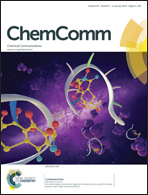C–H nitrogenation and oxygenation by ruthenium catalysis
Abstract
Remarkable recent progress has been accomplished in direct C–H functionalizations for the formation of C–N and C–O bonds through the use of readily accessible ruthenium catalysts. Particularly, ruthenium(II) complexes allowed for challenging direct C(sp2)–H hydroxylation of arenes. These catalysts set the stage for step-economical C–H functionalization with electron-rich as well as electron-deficient (hetero)arenes and, therefore, provided versatile access to diversely decorated phenols. While a number of synthetically useful protocols for ruthenium-catalyzed C(sp3)–H bond nitrogenation have been elaborated, the analogous transformations of more stable C(sp2)–H bonds were very recently achieved.


 Please wait while we load your content...
Please wait while we load your content...